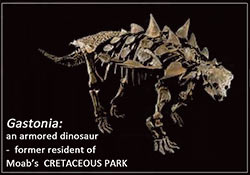 |
| Utahraptor, the Utah state dinosaur, is the largest of the raptors and was probably feathered like other raptors. The sickle claw is the most famous raptor feature. |
It is one thing to talk about a new dinosaur destination, and another to realize long-held paleo-plans have come to fruition. The first destinations to appear on the Dinosaur Diamond map entered Paleontological history more than a century ago. But, all things evolve, and 2021 will go down in paleontological history as the year that Utahraptor State Park became a reality. As noted in other Paleo Happenings articles, Utah’s Cretaceous dinosaurs constitute a well-kept secret, partly because Jurassic dinosaurs like the giant brontosaurs and Stegosaurus were the first to grab the limelight. Not to be out done, Cretaceous Utahraptor is now a local hero well-known to well-informed Moabites.
The sickle-clawed raptors, the name means predator or thief, have gained much attention partly because of great names like Velociraptor (speedy thief) and Oviraptor (egg thief). Most of these speedy raptors were small, chicken- or turkey-sized and feathered, like Microraptor and Bambiraptor, but Utahraptor was a relative giant, a king of the raptors, about 15 feet long. It is now the Cretaceous-aged Utah State dinosaur, joining Jurassic Allosaurus the state ‘fossil’ in paleontological history. At least eight Utahraptor were excavated from 130-135 million year old rocks of the Cedar Mountain Formation near Dalton Wells, future home of the state park. Nearby the Utah Geological Survey excavated a 9-ton block with thousands of baby and adult Utahraptor bones, which take many thousands of hours to extract.
 |
| Gastonia is the locally-famous armored “tank” dinosaur, adopted as the mascot for the local chapter of the Utah Friends of Paleontology. |
Few dinosaurs could be more different from the raptors than the heavily armored ankylosaurs known as the “prehistoric tanks” of the Cretaceous. One such tank was discovered near Castle Dale using a radiation detection device that picked up radioactive signals from the buried bone. It is said to be the first dinosaur ever discovered solely by technology. The Cedar Mountain Formation has earned its “Cretaceous Park” label thanks to the high diversity of dinosaurs, including five or more tank species from at least five different levels. One is named Cedarpelta, meaning pelt or shield bearer from the Cedar Mountain Formation). Another is named Gastonia named after Rob Gaston, an expert dinosaur restorer, is now the mascot for Moab’s local chapter of the Utah Friends of Paleontology (UFOP). Come to Moab Giants to see UFOP’s high-quality Gastonia replica made by Gaston himself.
Returning to Dalton Wells, a famous historic and prehistoric site, we learn a little of the work that went into excavating Moab’s own dinosaur Moabosaurus utahensis a member of the sauropod or brontosaur tribe. Before it was named in 2017, more than 5000 bones had been excavated from Dalton Wells, and detailed studies showed that many of the bones had been trampled and chewed by insects. Again, thousands of hours may go into restoring a ‘chewed up’ dinosaur skeleton for display.
 |
| Moabosaurus utahensis entered paleontological history in 2017. All dinosaurs illustrated here were found in the area newly-created Utahraptor State Park centered on the historic Dalton Wells area. |
Moab Residents will be aware that, besides celebrating its dinosaur treasures, one of the reasons for creating Utahraptor State Park is to alleviate the pressure placed on some 6500 acres of desert between Dalton Wells and Arches National Park by an ever-growing population of visitors in dinosaur-sized campers. According to the fossil evidence the population of Cretaceous dinosaurs in this area was also exceptionally high. The Utah Geological Survey in fact claims that the list of Cretaceous dinosaurs from Dalton Wells and other important sites constitutes the most diverse in the world. So, while Jurassic dinosaurs commanded the headlines for the last century, Moab’s dinosaurs have at last come into the spotlight as our neighborhood Cretaceous Park becomes a reality and an important “new” Dinosaur Diamond destination. |